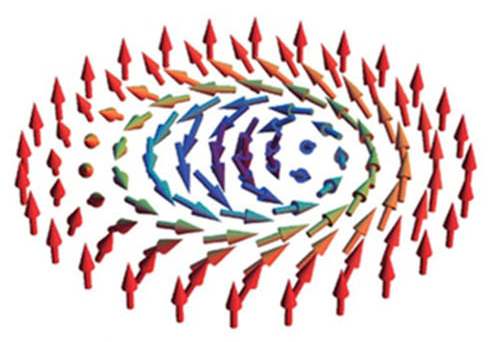An unusual type of magnetic quasiparticle that looks like a tiny, swirling bubble can one day be used as a computing bit in future memory devices after experts sped it up enough to transmit data.

In advancing memory storage devices, scientists recognize the need to store data more efficiently and densely in advanced components that can replace RAM and flash storage. For this reason, they attempted to replace electrons with "nanobubbles," also known as skyrmions.
What are Skyrmions?
Skyrmions are knots of twisting field lines, swirling quasiparticles, or subatomic hurricanes. They are composed of elementary nanomagnets, or spins, which wind to form a highly stable spiral structure.
The size of these particles can reach a few nanometers or about a dozen atoms. By contrast, a strand of human hair is up to 100,000 nanometers thick. Skyrmions generate themselves from magnetic field lines as they move through a medium.
The tiny nanobubbles offer great computing and information storage capacity and low energy consumption. They are considered future bits in computer memory as they provide enhanced platforms for information processing in electronic devices.
Experts have long theorized that skyrmions can potentially store data by encoding a 1 to denote its presence and encoding a 0 for its absence. Previous studies have also identified them as candidates for quantum computer qubits.
Current-Induced Skyrmion Motion
Magnetic skyrmions are topologically protected spin textures that potentially carry information in spintronic devices. While they can be manipulated with electric currents, their speeds in tracks are limited by phenomena like the skyrmion Hall effect, which damps and deflects the movement of skyrmions.
In a new study, researchers attempted to avoid this issue, which is typical of ferromagnets, using an antiferromagnet. Antiferromagnetic stacks comprise two nano-sized ferromagnetic layers, like cobalt, separated by a thick non-magnetic layer with opposite magnetization.
Until now, these nanobubbles do not move faster than 100 m/s, which is too slow for computing applications. Using an antiferromagnetic material as a medium, the researchers could move skyrmions ten times faster than previously observed.
An international research team led by experts from Centre National de la Recherche Scientifique (CNRS) has discovered that magnetic nanobubbles can be moved by electrical current, achieving record speeds up to 900 meters per second. The details of the study were discussed in the paper "Fast current-induced skyrmion motion in synthetic antiferromagnets."
The study is part of the SPIN national research program launched on January 29. This program supports innovative research in spintronics to help develop a more agile and enduring digital world. The SPIN Priority Research Program and Equipment (PEPR) is exploratory in connection with the France 2030 investment plan.
In this research, the scientists used synthetic antiferromagnetic material fabricated by sputtering. It was composed of two platinum/cobalt layers combined through a thin layer of ruthenium. Then, magnetic force microscopy was used to monitor the motion of skyrmions after current injections.
The research findings provide new prospects for developing higher-performance and less energy-intensive computing devices. The researchers suggest that skyrmions can be used to store information in a new type of "universal memory." Such a component involves a combination of short-term memory, like random access memory, and flash memory, like hard drives.
RELATED ARTICLE : Skyrmions Form Through He+ Ion Irradiation and Backside Reflecting Masks
Check out more news and information on Skyrmions in Science Times.
© 2025 ScienceTimes.com All rights reserved. Do not reproduce without permission. The window to the world of Science Times.












